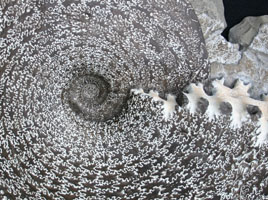Ammonites and baculites belong to the Phylum Mollusca and the Class Cephalopoda. Cephalopod is Latin for head-foot. Cephalopods represent the largest, most intellegent and agile group of the Phylum Mollusca. They have a distinct head, large eyes, a funnel, and a circle of arms with a pair of grasping tentacles around the mouth or beak. The foot of the cephalopod has been modified into a funnel, which can be pointed in different directions. Water is taken into the mantle and expelled through the funnel. The cephalopod is then pushed in the opposite direction from which the funnel is pointing. All cephalopods, except for some octopi, have either and external shell in which the animal lives in the last chamber or an internal shell that is linearly chambered or reduced in size.
Ammonites are similar to today's nautilus, and those of antiquity, in that they live in a chambered shell. As the animal grows it creates a new and larger chamber, closing off the old, smaller one. All the chambers are connected by a tube called a siphuncle which allowed the ammonite to rise or lower itself in the water. The chambers which the animal does not live in are called the phragmocone and are generally the parts which we find fossilized. Baculites were similar to ammonites except that after about one and a half coils the shell straightened out.
These cephalopods lived in a body of water known as the Pierre Seaway, which had depths ranging between 15 and 200 meters. This seaway ran through the middle of North America from Texas through Canada, including the states of Texas, New Mexico, Colorado, Nebraska, Kansas, Wyoming, Montana, and the Dakotas.
Placenticeras meeki is distinguished by its smooth convex, broad, nearly unornamented sides and smooth venter (its outside edge). Placenticeras meeki ranged in size up to 80 centimeters in diameter (about 32 inches) as opposed to Placenticeras intercalare which reaches up to 25 centimeters in diameter (about 10 inches). All Placenticeras species have a moderately involute umbilicus (the central whorl or spiral). Involute means small or tightly spiraled as opposed to evolute or broadly outward spiraling.
The original Placenticeras meeki specimen, from which this was cast, is available in our fossil ammonite section for $12,000.00.
Placenticeras meeki 
Quantity in Basket: None
Code: MOL-115
Price: $682.00
Shipping Weight: 6.87 pounds
Time: Campian age, approximately 75-72 million years ago.
Location: Fox Hills Formation, South Dakota, USA
Dimensions: 21" x 17" x 4-5/8"